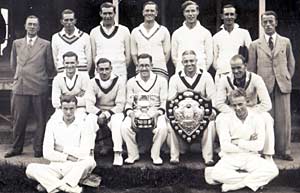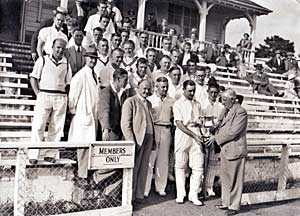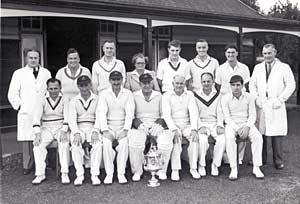
Heavitree Cricket Club, 1939 all out
Also see Sports Clubs and Leisure Centres
The face of Exeter cricket was never the same again after war broke out on September 3, 1939.
For at a stroke, a late cut as it were, Hitler’s unsportsmanlike behaviour ended the life of the city’s 29-year old Saturday league competition and the highly-successful Heavitree club as well.
The previous day, cricket’s more traditional enemy, rain, also stopped play as Heavitree faced the Gas Company in the Devon County Cup Final.
The Gas Company had made 80-5 at the time stumps were pulled (Harold Brewer 44, Arthur Venn 3-31) and there must have been a surreal atmosphere in the pavilion as the players sat around waiting for the showers to stop.
They had played all summer with storm clouds of another sort gathering over Europe. So it is difficult to believe that that Saturday or any weekend went by without a measure of anxious chatter as to the perils that might lie ahead.
The scorebook for the game contains a poignant list of absentees who couldn’t play because they had taken up military duties, most of them in the Territorial Army, and while sport in general gave everyone the chance to relax for a few hours each weekend, it must have been hard to give it 100 per cent concentration.
Finally, the cup final was abandoned and the players made their way home. Perhaps the teams planned to return the next week and finish things off. But Neville Chamberlain put an end to that idea when he produced his ominous piece of paper. Maybe the trophy was shared…but it became an irrelevance, anyway.
War stops play
So there it was. War declared. Stumps pulled up all over the country for goodness knows how long. Just not cricket, really.
As it happened, the league stumbled on until March, 1941, when a short item appeared in the Express and Echo under the headlines NO LEAGUE CRICKET, Exeter decision to suspend activities
The decision was similar to the one that had been taken between 1914 and 1919, and was necessary because only three clubs had indicated they were prepared to turn out that year.
Grounds had been lost, some to the need to ‘dig for victory’. And there was the obvious shortage of player.
The league had a credit balance of £8 and 6d, and the secretary, Mr J B Twigg, said: “I am confident that when the time comes we shall be ready and willing to do our share in re-establishing the league in its former flourishing state.”
The experiment of playing wartime cricket had been deemed a success in 1940.
The premier division title was shared that summer by Alphington and Rockbeare. The other teams in that division were Withycombe, Exeter Gas Co and St David’s OB. The Division One teams were Pinhoe, the Southern Railway SC, Rowe Bros and Pearse and Co.
Sadly, that particular Exeter and District League didn’t recover its “former flourishing state”, and apart from some 20-over matches and a cup competition on post-war evenings, the cricket diet in the 40s, 50s and 60s was based on friendly fixtures.
Later the pendulum swung again and league cricket is now the weekend vogue once more, now played on better wickets against clubs drawn from a wider geographical area than its predecessor.
The outbreak of war meant Heavitree finally lost their pitch and facilities within the grounds of Wonford House in Barrack Road, on an area now filled by the Royal Devon and Exeter Hospital.
Cricket in the 1930s
They had played there for over a decade, but in the latter years of the 1930s had faced a number of difficulties, including the building of a house for the superintendent of Wonford House Hospital, the ravages of hockey played across the square in winter and the digging of a drain across the same area.
Despite all that they were a proud and successful club as these battle honours indicate: Division One Shield winners 1924, runners-up 1931; Premier Division winners 1936, 1937, joint holders 1933, runners-up 1935; Devon County Cup winners 1927, 1932, 1938, joint holders 1930, 1939. Appearances in final, 1926, ‘27, ‘28, 1930, ‘32, ‘36, ‘37, ‘38, ‘39.
Club officials 1939: president, Lord Mamhead; chairman, Jack Ford; vice-chairman, C G Glass; treasurer, J Rowden; secretary, E G (Dan) Parsons, captain 1st X1, Bert (Jim) Garnham, vice-captain, Horace Walkey.
Their last scorebook is still in existence, as are a number of team photographs, in the possession of Philip Hoare, now living in Norfolk, whose father Eric, once sports editor of the Express and Echo, played for Heavitree as a fast bowler, taking 800 or more wickets.
He wrote about cricket in the Echo under the by-line, Willow, and a scrapbook of cuttings, started initially by a more senior Echo colleague in 1926, and then taken over by himself, chronicles much of the history of the Exeter and District League until 1930.
Sadly, a later volume, covering the 1930s, has been lost.
Padded up again
Heavitree folded competitively in 1939, but their spirit outlasted the war and on Sunday, September 13, 1953, Old Heavitree, played the first of a series of annual matches against Filleigh CC in North Devon, where one of their former colleagues, Bob McRae, then played.
Old Heavitree enjoyed those days out, and players and wives and 10-year-old Philip, piled on to a charabanc, happy to talk over old times and put on the whites together again.
The journey home included a sing-song including many wartime favourites, as the bus sped back to Exeter, and the event was marked by the compiling of a small brochure, Cricket Calling, edited by Willow.
By 1953, he and other old Heavitree colleagues were playing for St James’s CC. Others were with Whipton, St Thomas’s, the Gas Company and Crediton, and rarely a weekend went by without old league colleagues and adversaries meeting up. It was an extended family, playing hard but fairly, as befitted the friendly fixtures and always ready to give youngsters a chance.
Back to the beginning
One generation of cricketers helps the next and that is how it had been since the Exeter and District League’s inception in October, 1910, when 16 clubs signed up to play.
By 1926, the year of the General Strike, the league had three senior divisions, a minor league and an elementary schools’ competition as well.
The senior clubs (some with more than one team, reading down from the top of Division One into Division Three, were: Exe Valley, Topsham, Heavitree, Sid Vale, St James, Thorverton, Exmouth, St Thomas, St Mark’s, Rockbeare, Clyst St George, Ide, Bradninch, Killerton, Christhurch, YMCA, Alphington, St David’s Institute and Whimple.
The Exeter Minor League
The Minor League comprised Heavitree Cons, Toc H, Exmouth Park, St Thomas Amateurs, Christchurch, St Nicholas, Exe Valley, Bartholemew St Baptists, St Thomas and St Matthews.
The schools were: St Sidwell’s, Newtown, Central, Mint, St David’s, Episcopal, St James’, John Stocker, Ladysmith, St John’s, Heavitree Par, and Practising.
There are pages and pages of lengthy cuttings in the scrapbook: match reports, club and league averages, annual meetings, league meetings and representative games, and the league remained buoyant for another 13 years.
The match reports indicate poor playing conditions. Scores were generally low, with teams sometimes bowled out twice on a Saturday afternoon and bowlers in particular returning some extraordinary analyses.
But there were star performers as well, and occasionally a player was good enough to turn out for Devon.
Ground improvement was an issue for the league, as were experiments with the game in general which came down from on high. Changes in the LBW law inevitably, and even a change in the width of the pitch in the late 1920s.
Eric Hoare the cricket lover
Thousands and thousands of words in carefully crafted reports, the quality of which brought recognition for Willow in 1929 (at the age of 18) at the league’s annual dinner held at Deller’s Café.
The report read: “The Press having been toasted, on the motion of Mr F C Harris (league treasurer), the president made a presentation to Willow of the Express and Echo in recognition of services rendered to the league through the medium of the weekly notes."
“The gift, a handsome trophy in oxidised silver, depicts a batsman in action. The accompanying tablet was suitably inscribed. The recipient replied.”
Philip still has the trophy, and followed his father both as a sports journalist and a cricketer, a wicket-keeper playing for Alphington, Exeter St James’s and Exeter St Thomas.
He went to Exeter School and was a reporter on the Express and Echo until 1964 when he moved away, finally to Norfolk where he is now retired.
Eventually, his father’s love for the game, and his enthusiastic coverage of it in the sports pages of the Echo, led to him being elected president of the Exeter and District Evening Cricket League before his death in 1977.
© 2008 Philip Hoare
Philip Hoare worked for the Express and Echo until 1964, when he moved to work for a newspaper in Sussex. His father, Eric Hoare, was sports editor of the Echo, and as Willow, wrote a cricket column in the 1930's. This short history of Heavitree CC covers the years from the 1920s to the 1950s.
 Heavitree Cricket Club the
the 1930's.
Heavitree Cricket Club the
the 1930's.
 Heavitree Cricket Club
were beaten by Sidmouth in the Devon County Cup
in 1937. The final was at Pennsylvania.
Heavitree Cricket Club
were beaten by Sidmouth in the Devon County Cup
in 1937. The final was at Pennsylvania.
 St James's CC skipper Frank
Pile with the Sim Cup in the early 1950s.
St James's CC skipper Frank
Pile with the Sim Cup in the early 1950s.
 Old Heavitree Cricket Club in
1955 at Paul Street bus station on a trip
to Filleigh in North Devon.
Old Heavitree Cricket Club in
1955 at Paul Street bus station on a trip
to Filleigh in North Devon.
│ Top of Page │